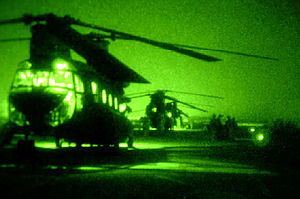Battle of Baqubah
| Battle of Baqubah | |||||||
|---|---|---|---|---|---|---|---|
| Part of the Iraq War (Diyala province campaign) | |||||||
 Soldiers have a short meeting at an airfield in Baqubah before an air assault into an outlying village of the city, 18 June 2007. |
|||||||
|
|||||||
| Belligerents | |||||||
|
|
|
||||||
| Commanders and leaders | |||||||
| COL Stephen Townsend, LTC Antonia, LTC Smiley, LTC Goins | Unknown | ||||||
| Strength | |||||||
| Approximately 700 combat troops and 2,000 support troops between 14 March and 17 June 2007, Approximately 2,000 combat troops and 5,000 support troops between 18 June and 31 August 2007. | Approximately 2,000-3,000 | ||||||
| Casualties and losses | |||||||
| 22 killed, 40 wounded (U.S. Task Force Regulars 14–17 March June 2007); 9 killed, 15 wounded (U.S. Operation Arrowhead Ripper 18–31 June August 2007); 7 killed, 15 wounded (Iraqi Army); 2 killed (U.S.-allied Iraqi militia) 3 killed (Iraqi police) |
227+ killed, some 100 detained |
||||||
The Battle of Baqubah II (March–August 2007) took place during the Iraq War in the capital of the Iraqi province Diyala, to the north-east of Baghdad. It began in early March 2007, when US and Iraqi forces commenced preliminary operations to "establish a presence in Diyala beyond their Forward Operating Base".
In June 2007 as part of a larger country wide offensive, Operation Arrowhead Ripper was launched to gain control of Baqubah and its surrounding areas from the insurgents. Baqubah was largely pacified as a result of this operation although insurgent presence still remained in the capital and throughout the province.
In August 2007, Operation Phantom Strike was launched throughout northern Iraq in order to capitalize on the gains made during Operation Phantom Thunder. As part of this offensive, Operation Lightning Hammer was launched to the northeast of Baqubah.
In mid-October 2006, al-Qaeda announced the creation of Islamic state of Iraq (ISI), replacing the Mujahideen Shura Council (MSC) and its al-Qaeda in Iraq (AQI).
In late 2006, al-Qaeda in Iraq forces began a quiet troop build-up in Baqubah, naming it the capital of their "Islamic State of Iraq". As a result of the Baghdad Security Plan, in early 2007 Al Qaeda in Iraq forces withdrew from Baghdad in large numbers and began furthering operations in Diyala province. Emma Sky describes it as, at that time, the most violent part of Iraq. The insurgents fortified the province with observation posts, fighting positions, mines, and booby-trapped houses, as well as establishing supply bases and training camps. The large majority of these forces were positioned in the city of Baqubah, which was of great importance to Al Qaeda forces, having been declared the Capital of the Islamic State of Iraq. Military Intelligence templated the Al Quieda forces within the city at 2500 fighters, and an additional 500 support forces.
A tactic employed by the insurgents in Buhriz was hit-and-run attacks with RPGs. With the support of Apache gunships firing Hellfire missiles, U.S. forces were able to inflict between 40 and 50 insurgent casualties on 14 March.
...
Wikipedia
